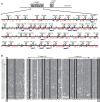C19MC microRNAs are processed from introns of large Pol-II, non-protein-coding transcripts
- PMID: 19339516
- PMCID: PMC2691840
- DOI: 10.1093/nar/gkp205
C19MC microRNAs are processed from introns of large Pol-II, non-protein-coding transcripts
Abstract
MicroRNAs are tiny RNA molecules that play important regulatory roles in a broad range of developmental, physiological or pathological processes. Despite recent progress in our understanding of miRNA processing and biological functions, little is known about the regulatory mechanisms that control their expression at the transcriptional level. C19MC is the largest human microRNA gene cluster discovered to date. This 100-kb long cluster consists of 46 tandemly repeated, primate-specific pre-miRNA genes that are flanked by Alu elements (Alus) and embedded within a approximately 400- to 700-nt long repeated unit. It has been proposed that C19MC miRNA genes are transcribed by RNA polymerase III (Pol-III) initiating from A and B boxes embedded in upstream Alu repeats. Here, we show that C19MC miRNAs are intron-encoded and processed by the DGCR8-Drosha (Microprocessor) complex from a previously unidentified, non-protein-coding Pol-II (and not Pol-III) transcript which is mainly, if not exclusively, expressed in the placenta.
Figures




References
-
- Bushati N, Cohen SM. microRNA functions. Annu. Rev. Cell Dev. Biol. 2007;23:175–205. - PubMed
-
- Kim VN. MicroRNA biogenesis: coordinated cropping and dicing. Nat. Rev. Mol. Cell Biol. 2005;6:376–385. - PubMed
-
- Kim VN, Han J, Siomi MC. Biogenesis of small RNAs in animals. Nat. Rev. Mol. Cell Biol. 2009;10:126–139. - PubMed
-
- Filipowicz W, Bhattacharyya SN, Sonenberg N. Mechanisms of post-transcriptional regulation by microRNAs: are the answers in sight? Nat. Rev. Genet. 2008;9:102–114. - PubMed
Publication types
MeSH terms
Substances
LinkOut - more resources
Full Text Sources
Other Literature Sources
Research Materials

